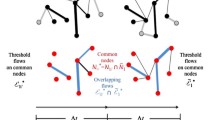Abstract
This paper uses firm-level data recorded in the Amadeus database to investigate the distribution of labour productivity in different European countries. We find that the upper tail of the empirical productivity distributions follows a decaying power-law, whose exponent α is obtained by a semi-parametric estimation technique recently developed by Clementi et al. [Physica A 370(1):49–53, 2006]. The emergence of “fat tails” in productivity distribution has already been detected in Di Matteo et al. [Eur Phys J B 47(3):459–466, 2005] and explained by means of a model of social network. Here we show that this model is tested on a broader sample of countries having different patterns of social network structure. These different social attitudes, measured using a social capital indicator, reflect in the power-law exponent estimates, verifying in this way the existence of linkages among firms’ productivity performance and social network.
Similar content being viewed by others
References
Ahuja G (2000) Collaboration networks, structural holes, and innovation: a longitudinal study. Adm Sci Q 45(3): 425–455
Albert R, Barabási AL (2002) Statistical mechanics of complex networks. Rev Mod Phys 74(1): 47–97
Andrews DWK, Buchinsky M (2000) A three-step mehod for choosing the number of bootstrap repetitions. Econometrica 68(1): 23–51
Bourdieu P (1996) The state nobility: elite schools in the field of power. Polity Press, Cambridge
Burt RS (2000) The network structure of social capital. In: Sutton RI, Staw BM(eds) Research in organizational behavior. Elsevier Science JAI, Amsterdam, London, pp 345–423
Clementi F, Di Matteo T, Gallegati M (2006) The power-law tail exponent of income distributions. Physica A 370(1): 49–53
Cohen D, Prusak L (2001) In good company: how social capital makes organizations work. Harvard Business School Press, Boston
Coleman JS (1988) Social capital in the creation of human capital. Am J Sociol 94(Supplement): S95–S120
Coleman JS (1990) Foundations of social theory. Harvard University Press, Cambridge
Cooper RW (1999) Coordination games: complementarities and macroeconomics. Cambridge University Press, Cambridge
Di Giacinto V, Nuzzo G (2006) Explaining labour productivity differentials across Italian regions: the role of socio-economic structure and factor endowments. Pap Reg Sci 85(2): 299–320
Di Matteo T, Aste T, Hyde ST (2004) Exchanges in complex networks: income and wealth distributions. In: Mallamace F, Stanley HE (eds) The Physics of complex systems (new advances and perspectives). IOS Press, Amsterdam, pp 435–442
Di Matteo T, Aste T, Gallegati M (2005) Innovation flow through social networks: productivity distribution in France and Italy. Eur Phys J B 47(3): 459–466
DuMouchel WH (1983) Estimating the stable index α in order to measure tail thickness: a critique. Ann Stat 11(4): 1019–1031
Fukuyama F (2000) Social capital and civil society. IMF Working Paper 00/74. http://ssrn.com/abstract=879582
Granovetter M (1985) Economic action and social structure: the problem of embeddedness. Am J Sociol 91: 481–510
Granovetter M (2005) The impact of social structure on economic outcomes. J Econ Perspect 19(1): 33–50
Guiso L, Sapienza P, Zingales L (2004) The role of social capital in financial development. Am Econ Rev 94(3): 526–556
Hall P, Welsh AH (1985) Adaptive estimates of parameters of regular variation. Ann Stat 13(1): 331–341
Hill BM (1975) A simple general approach to inference about the tail of a distribution. Ann Stat 3(5): 1163–1174
Knack S, Keefer P (1997) Does social capital have an economic payoff? A cross-country investigation. Q J Econ 112(4): 1251–1288
Lux T (1996) The stable Paretian hypothesis and the frequency of large returns: an examination of major German stocks. Appl Financ Econ 6(6): 463–475
Motohashi K (2007) Firm-level analysis of information network use and productivity in Japan. J Jpn Int Econ 21(1): 121–137
Nolan JP (1997) Numerical calculation of stable densities and distribution functions. Comm Stat Stoch Models 13(4): 759–774
Nolan JP (1999a) An algorithm for evaluating stable densities in Zolotarev’s (M) parameterization. Math Comput Model 29(10): 229–233
Nolan JP (1999b) Fitting data and assessing goodness-of-fit with stable distributions. In: Nolan JP, Swami A(eds) Proceedings of the ASA-IMS conference on applications of heavy tailed distributions in economics, engineering and statistics. American University, Washington DC
Nolan JP (2001) Maximum likelihood estimation of stable parameters. In: Mikosch T, Resnick SI (eds) Lévy processes: theory and applications. Birkhäuser, Boston, pp 379–400
Pammolli F, Riccaboni M (2001) Technological regimes and the growth of networks: an empirical analysis. LEM Working Paper Series 2001/07, Sant’Anna School of Advanced Studies of Pisa. http://www.lem.sssup.it/WPLem/files/2001-07.pdf
Pittaway L, Robertson M, Munir K, Denyer D, Neely A (2004) Networking and innovation: a systematic review of the evidence. Int J Manag Rev 5–6(3–4): 137–168
Portes A (1998) Social capital: its origins and applications in modern sociology. Annu Rev Sociol 24(1): 1–24
Putnam RD (1995) Tuning in, tuning out: the strange disappearance of social capital in America. PS-Polit Sci Polit 28(4): 664–683
Putnam RD (2000) Bowling alone: the collapse and revival of American community. Simon & Schuster, New York
Rogers EM (2003) Diffusion of innovation, 5th edn. Free Press, New York
Rosenfeld MTW, Franz P, Gunther J, Heimpold G, Kawka R, Kronthaler F, Barkholz M (2004) Innovative kompetenzfelder, produktionsnetzwerke und branchenschwerpunkte der ostdeutschen wirtschaft. Endbericht, a study at the Institute für Wirtschaftsforschung Halle, IWH
Sabatini F (2006) Does social capital improve labour productivity in small and medium enterprises? Working Paper 92, University “La Sapienza” of Rome. http://dep.eco.uniroma1.it/docs/working_papers/Wp92.pdf
Solow RM (1995) Trust: the social virtues and the creation of prosperity (book review). New Repub 213(5): 36–40
Uhlig H (2006) Regional labor markets, network externalities and migration: the case of German reunification. Am Econ Rev 96(2): 383–387
Vecernik J (2003) Skating on thin ice: a comparison of work values and job satisfaction in CEE and EU countries. Int J Comp Sociol 44(5): 444–471
Author information
Authors and Affiliations
Corresponding author
Rights and permissions
About this article
Cite this article
Di Guilmi, C., Clementi, F., Di Matteo, T. et al. Social networks and labour productivity in Europe: an empirical investigation. J Econ Interac Coord 3, 43–57 (2008). https://doi.org/10.1007/s11403-008-0034-6
Published:
Issue Date:
DOI: https://doi.org/10.1007/s11403-008-0034-6
Keywords
- Labour productivity
- Power-law distribution
- Semi-parametric bootstrap approach
- Social networks
- Social capital




